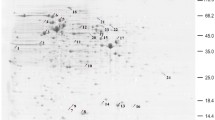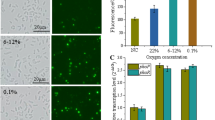Abstract
Maintenance of a circumneutral intracellular pH is important for any organism. Acidophilic microorganisms thrive at low pH while maintaining their intracellular pH around 6.5. However, the mechanisms contributing to acidophile pH homeostasis are not well characterized. The authors investigated the proteomic response and cytoplasmic membrane fatty acid profiles of Acidithiobacillus caldus toward three pH values: 1.1, 2.5, and 4.0. Major rearrangements were observed but lower pH elicited larger changes. Differentially expressed transcription factors suggested tight transcriptional control of pH induced genes. Enzymes involved in sulfur metabolism were up-regulated at pH 1.1 suggesting either that: (1) cells required more energy for maintenance or (2) increased metabolic activity was a specific acid stress response to export intracellular protons via 1° electron transport proton pumps. Furthermore, glutamate decarboxylase, an important enzyme in Escherichia coli acid resistance, was uniquely expressed at pH 1.1. Other proteins previously shown to be involved in neutrophilic acid response, such as spermidine synthase, PspA, and toluene tolerance protein, were differentially expressed in At. caldus but require further investigation to show a direct link to pH homeostasis. Their roles in acidophilic organisms are discussed. Active modulation of fatty acid profiles was detected and suggested a more rigid membrane at low pH.



Similar content being viewed by others
References
Anderson NL (1991) Two dimensional gel electrophoresis: operation of the ISO-DALT system. Large Scale Biology Press, Rockville
Baker-Austin C, Dopson M (2007) Life in acid: pH homeostasis in acidophiles. Trends Microbiol 15:165–171
Bull AT (2010) The renaissance of continuous culture in the post-genomics age. J Ind Microbiol Biotechnol 37:993–1021
Castanie-Cornet MP, Penfound TA, Smith D, Elliot JF, Foster JW (1999) Control of acid resistance in Escherichia coli. J Bacteriol 181:3525–3535
Chang Y–Y, Cronan JE (1999) Membrane cyclopropane fatty acid content is a major factor in acid resistance of Escherichia coli. Mol Microbiol 33:249–259
Chao J, Wang W, Xiao S, Liu X (2008) Response of Acidithiobacillus ferrooxidans ATCC 23270 gene expression to acid stress. World J Microbiol Biotech 24:2103–2109
Chu-Ky S, Tourdot-Marechal R, Marechal P-A, Guzzo J (2005) Combined cold, acid, ethanol shocks in Oenococcus oeni: effects on membrane fluidity and cell viability. Biochim Biophys Acta 1717:118–124
Cox JC, Nicholls DG, Ingledew WJ (1979) Transmembrane electrical potential and transmembrane pH gradient in the acidophile Thiobacillus ferrooxidans. Biochem J 178:195–200
Dopson M, Lindström EB (1999) Potential role of Thiobacillus caldus in arsenopyrite bioleaching. Appl Environ Microbiol 65:36–40
Dopson M, Lindstrom EB, Hallberg KB (2002) ATP generation during reduced inorganic sulfur compound oxidation by Acidithiobacillus caldus is exclusively due to electron transport phosphorylation. Extremophiles 6:123–129
Driessen AJM, van de Vossenberg JLCM, Konings WN (1996) Membrane composition and ion-permeability in extremophiles. FEMS Microbiol Rev 18:139–148
Foster JW (2004) Escherichia coli acid resistance: tales of an amateur acidophile. Nat Rev Microbiol 2:898–907
Guiliani N, Jerez CA (2000) Molecular cloning, sequencing, and expression of omp-40, the gene coding for the major outer membrane protein from the acidophilic bacterium Thiobacillus ferrooxidans. Appl Environ Microbiol 66:2318–2324
Huvet M, Toni T, Sheng X, Thorne T, Jovanovic G, Engl C et al (2011) The evolution of the phage shock protein response system: interplay between protein function, genomic organization, and system function. Mol Biol Evol 28:1141–1155
Joly N, Engl C, Jovanovic G, Huvet M, Toni T, Sheng X et al (2010) Managing membrane stress: the phage shock protein (Psp) response, from molecular mechanisms to physiology. FEMS Microbiol Rev 34:797–827
Jovanovic G, Lloyd LJ, Stumpf MPH, Mayhew AJ, Buck M (2006) Induction and function of the phage shock protein extracytoplasmic stress response in Escherichia coli. J Biol Chem 281:21147–21161
Jovanovic G, Engl C, Buck M (2009) Physical, functional and conditional interactions between ArcAB and phage shock proteins upon secretin-induced stress in Escherichia coli. Mol Microbiol 74:16–28
Kannenberg EL, Poralla K (1999) Hopanoid biosynthesis and function in bacteria. Naturwissenschaften 86:168–176
Kobayashi R, Suzuki T, Yoshida M (2007) Escherichia coli phage-shock protein A (PspA) binds to membrane phospholipids and repairs proton leakage of the damaged membranes. Mol Microbiol 66:100–109
Konings WN, Albers SV, Koning S, Driessen AJM (2002) The cell membrane plays a crucial role in survival of bacteria and archaea in extreme environments. Antonie Van Leeuwenhoek Int J Gen Mol Microbiol 81:61–72
Krulwich TA, Sachs G, Padan E (2011) Molecular aspects of bacterial pH sensing and homeostasis. Nat Rev Micro 9:330–343
Mangold S, Valdés J, Holmes D, Dopson M (2011) Sulfur metabolism in the extreme acidophile Acidithiobacillus caldus. Front Microbiol 2. doi:10.3389/fmicb.2011.00017
Molloy M (2008) Isolation of bacterial cell membranes proteins using carbonate extraction. Methods Mol Biol 424:397–401
Mykytczuk N, Trevors J, Ferroni G, Leduc L (2010) Cytoplasmic membrane fluidity and fatty acid composition of Acidithiobacillus ferrooxidans in response to pH stress. Extremophiles 14:427–441
Poralla K, Kannenberg E (1987) Hopanoids: sterol equivalents in bacteria. In: Ecology and metabolism of plant lipids. American Chemical Society, pp 239–251
Samartzidou H, Mehrazin M, Xu Z, Benedik MJ, Delcour AH (2003) Cadaverine inhibition of porin plays a role in cell survival at acidic pH. J Bacteriol 185:13–19
Schäfer G, Purschke W, Schmidt CL (1996) On the origin of respiration: electron transport proteins from archaea to man. FEMS Microbiol Rev 18:173–188
Slonczewski JL, Fujisawa M, Dopson M, Krulwich TA (2009) Cytoplasmic pH measurement and homeostasis in bacteria and archaea. Adv Microb Physiol 55(1–79):317
Suzuki I, Lee D, Mackay B, Harahuc L, Oh JK (1999) Effect of various ions, pH, and osmotic pressure on oxidation of elemental sulfur by Thiobacillus thiooxidans. Appl Environ Microbiol 65:5163–5168
Thürmer A, Voigt B, Angelov A, Albrecht D, Hecker M, Liebl W (2011) Proteomic analysis of the extremely thermoacidophilic archaeon Picrophilus torridus at pH and temperature values close to its growth limit. Proteomics 11:4559–4568
Wortham B, Oliveira M, Patel C, Perry RD, Fetherston JD (2007) Polyamines in bacteria: pleiotropic effects yet specific mechanisms. In: the genus Yersinia. Springer, New York, pp 106–115
Acknowledgments
The authors thank Krister Lundgren and Thomas Moritz at the Swedish Metabolomics Center, Swedish University of Agricultural Sciences, Umeå, for FAME analysis as well as BILS (Bioinformatics Infrastructure for Life Sciences), Umeå University, for help with PCA. Funding from the Swedish Research Council (Vetenskapsradet contract number 621-2007-3537) is acknowledged. This project was carried out in conjunction with Cost action CM0902—Molecular machineries for ion translocation across biomembranes.
Author information
Authors and Affiliations
Corresponding author
Additional information
Communicated by A. Driessen.
Electronic supplementary material
Below is the link to the electronic supplementary material.
Rights and permissions
About this article
Cite this article
Mangold, S., rao Jonna, V. & Dopson, M. Response of Acidithiobacillus caldus toward suboptimal pH conditions. Extremophiles 17, 689–696 (2013). https://doi.org/10.1007/s00792-013-0553-5
Received:
Accepted:
Published:
Issue Date:
DOI: https://doi.org/10.1007/s00792-013-0553-5




